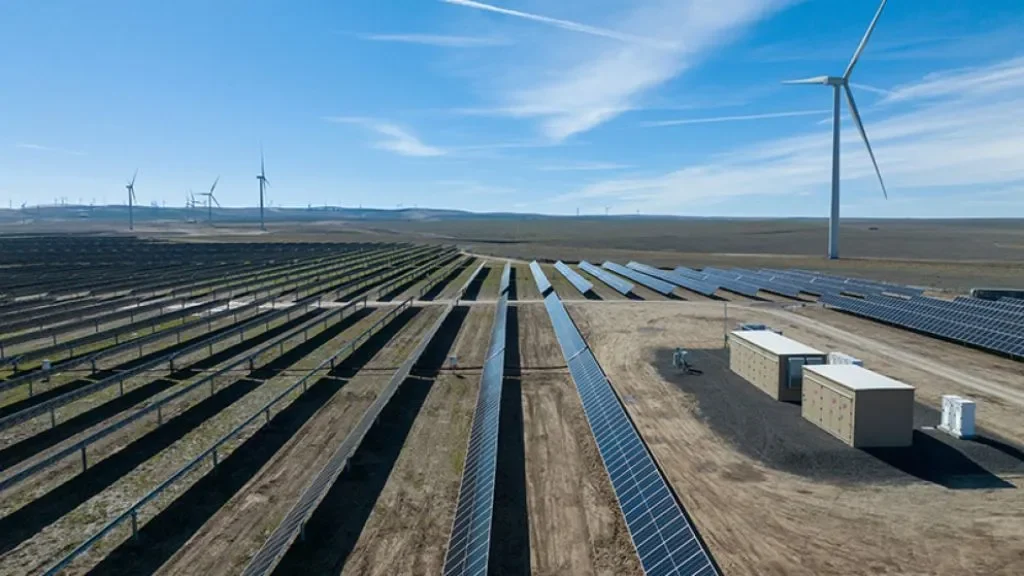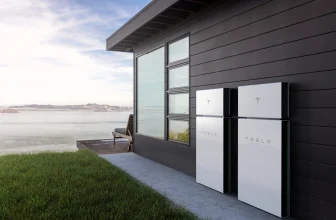Imagine combining two superheroes, each with their unique powers, to create a dynamic duo that’s more powerful together than they are individually. That’s the basic idea behind combining wind turbines and solar panels in a solar wind hybrid system.
How efficient can these wind and solar kits be? Here are the results from the National Renewable Energy Laboratory (NREL) study: solar and wind power displace fossil fuels. A 35% penetration of solar and wind power would reduce fuel costs by 40% and carbon emissions by 25%–45% (the rough equivalent of taking 22–36 million cars off the road) compared to today’s system.
Furthermore, the research report by Global Market Insights, Inc. indicates that the U.S. hybrid solar and wind power market was $195 million in 2015 and may reach over $300 million in 2024.
The first thing to consider is that the combination of wind turbines and solar panels is profitable and environmentally beneficial for humanity.

Source Inside Climate News
How Does It Work?
Integrating wind turbine with solar panel provides energy reliability, as wind and solar power often complement each other regarding availability. Below are technical details explaining how a wind turbine and solar panel combination works and what are its key components.
Winds blow and spin the turbines, solar panels take the sun baths – and both produce solar and wind power. Combining wind turbines and solar panels provides a continuous and stable solar and wind power supply. Excess electricity from windmills and solar panels is directed to the charge controller. The charge controller manages the charging of batteries, ensuring they are not overcharged or depleted.
Solar and wind power that is not immediately needed is stored in batteries for later use. Batteries act as an additional supply, providing power during periods of low or no generation. The inverter converts DC electricity from the batteries into AC for use in the home or to feed into the grid. In case of grid outages, the inverter/charger may also work in reverse, converting AC electricity from the backup generator into DC for storage in the batteries.
The Power Conditioning Unit (PCU) coordinates the flows of solar and wind power between the wind turbines, solar panels, battery storage, and electrical loads. It ensures a smooth transition between different power sources and optimizes the overall efficiency of wind turbine and solar panel combination.
Key Operational Considerations
By combining solar and wind power sources with energy storage, a wind turbine and solar panel combination offers a reliable and sustainable solution for meeting electricity needs in various conditions. Integrating various components ensures a continuous and efficient operation, contributing to energy independence and sustainability.
- Load Prioritization: The system is meant to prioritize supplying solar and wind power to critical loads within the home first, ensuring that important equipment inside the house gets a steady power supply during the ups and downs.
- Automatic Switching: Solar and wind system is designed to switch between different power sources automatically based on real-time conditions, optimizing wind solar energy use and storage.
- Integration with the Grid: Solar wind hybrid system systems can be grid-connected, allowing homeowners to sell excess electricity when generation exceeds demand and draw power from the grid during periods of low generation or high demand.
- System Control and Monitoring: Advanced solar and wind power hybrid systems may include control systems with monitoring capabilities. Homeowners can monitor energy production, battery status, and overall wind turbines and solar panels performance.
- Backup Generator (Optional): A backup generator can provide additional power during extended periods of low renewable energy generation and depleted battery storage.

Source ScienceDirect
Advantages of the Hybrid Wind and Solar System:
- Always Ready for Action: Solar and wind energy work well as tag-team partners. Solar panels work when it’s sunny, and wind turbines kick in when it’s windy (even at night). This means a more reliable and consistent renewable solar and wind power supply.
- Steady Performance: Think of it like having a backup plan. If one superhero takes a break, the other steps up. Combining wind turbines and solar panels helps to even out the ups and downs, providing a steady power supply.
- Using Nature’s Gifts: Different places have different types of weather. By combining solar and wind power, we make the most of what nature has to offer in a specific location, grabbing energy from the wind when it’s blowing and from the sun when it’s shining.
- More Power, Less Space: It’s like having a superhero team up in a single location. Wind turbines and solar panels working side by side can generate more power without much space.
Where Wind Turbine and Solar Panel Combination Works the Best
This superhero team-up can work in far-off locations without a regular power source or in places already connected to the power grid. It’s like having a versatile team that can adapt to different situations.
1) Solar and Wind Hybrid System for Home
Combining wind turbines and solar panels can fit various households, particularly those with specific energy needs, sustainability goals, or unusual geographical conditions. Here are types of households that may find a wind solar generator beneficial:
- Off-Grid Homes: A wind solar hybrid system provides a reliable and sustainable power source, ensuring continuous solar energy and wind energy supply in off-grid locations.
- Eco-Friendly Homes: wind turbines and solar panels align with eco-friendly practices, allowing homeowners to generate clean solar and wind power and reduce reliance on conventional power sources.
- Homes with Different Energy Needs: Solar and wind power can complement each other, providing power during different seasons, weather conditions, or times of the day.
- Homes in Windy Locations: Wind turbines can be especially effective in windy locations, providing a continuous energy source, even at night or on cloudy days without sunlight.
- Homes in Rural or Agricultural Areas: Homes on farms or rural settings often have open spaces suitable for wind turbines and solar panels installations. A wind turbine and solar panel combination can contribute to energy self-sufficiency for home and agricultural operations.
- Resilient Homes: These are homes in areas prone to power shortages or unreliable grid connections. A wind turbine and solar panel combination, especially with home batteries, improve wind and solar power flexibility during grid disruptions.
- Smart Homes: wind turbines and solar panels can be integrated with smart home systems to optimize energy usage based on weather conditions, power demand, and user preferences.
2) Wind Turbine and Solar Panel Combination for Business
Cutting the costs – that is an essential part of every business. There is no way your business can exist if the profits are vaporized every month with electricity grids. Here are the types of companies that will profit from installing solar and wind systems.
- Remote or Off-Grid Facilities: Wind turbines and solar panels can provide a reliable and steady solar and wind power source for remote cabins, research stations, and telecommunications towers where access to the electrical grid is limited or expensive.
- Agricultural Operations: Farms, greenhouses, irrigation systems. Farms often have large open spaces suitable for solar and wind system. Wind turbines and solar panels can help power irrigation systems and other farm operations.
- Resorts and Eco-Lodges: Eco-friendly resorts, lodges, and nature retreats. Solar and wind systems align with such establishments’ sustainable and eco-friendly image. They can provide clean energy without relying solely on conventional power sources.
- Industrial Facilities: Manufacturing plants, warehouses, industrial parks. Industries with substantial energy needs may benefit from wind turbines and solar panels to reduce dependence on traditional grid power, lower operational costs, and attach a green image to the brand.
- Fishing and Maritime Operations: Fishing vessels and seafood processing plants. Wind turbines can be integrated into maritime structures, and solar panels can provide power during daytime operations, making this an ideal combination for certain marine businesses.
- Microgrids for Communities: Rural communities, island communities. Solar and wind system can contribute to community microgrids, providing a mix of reliable solar and wind power sources, especially in areas with unstable grids.
- Tourism and Recreational Facilities: Campgrounds, adventure parks, outdoor recreational areas. Wind turbines and solar panels match the eco-friendly and environmental trends in the tourism industry, providing clean energy for facilities in natural settings.
- Data Centers: Server farms and data storage facilities. They require continuous power. A wind turbine and solar panel combination can offer a reliable green solar and wind power source, contributing to corporate environmental goals.
- Waste Treatment and Recycling Centers: Landfill facilities, recycling plants. Wind turbine and solar panel combination can support energy-intensive waste treatment and recycling processes, contributing to sustainable waste management practices.
Costs and Considerations
That’s not cheap, for sure. Some businesses, like the Wheatridge Renewable Energy Facility in Lexington, Oregon, build huge solar and wind power plants that produce and store up to 300 mW of wind and solar energy. It is the first solar and wind power plant in North America that combines solar and wind power with battery storage. They pay millions – but the payoff is much higher, providing economic and environmental profits. But let’s consider how much the “civil” version of the solar wind hybrid system might cost.
An average home consumption is 6 kW. So, let’s calculate how much your wind turbine and solar panel combination will take from your pocket.
| Wind Turbine | Assuming $3,500 per installed kW for the wind turbine | $3,500/kW * 6 kW = $21,000 |
| Solar Panels | $2.50 per installed watt for solar | $2.50/watt * 6,000 watts (6 kW) = $15,000 |
| Battery | 10 kW | $6000 |
| Additional equipment | Power Conditioning Unit (PCU), power controllers, inverters/converters, | $3000 |
| Total | $45000 |
Some specific details about connecting such a hybrid system are:
- You will need a hybrid inverter to handle AC and DC inputs from the wind turbine and solar panels and convert them to the appropriate voltage and frequency for your load or grid connection.
- You will also need a charge controller to regulate the charging and discharging of your battery bank and prevent overcharging or over-discharging.
- You must connect the wind turbine and solar panels to the hybrid inverter using wires and cables of the right size and type and follow the manufacturer’s and local authorities’ safety and installation guidelines.
- You will have to mount the wind turbine on a tower or pole that is high enough to catch the wind and secure it with guy wires or anchors. Mount the solar panels on an oriented and tilted rack or structure to maximize solar exposure.
- You must regularly monitor and maintain your solar wind hybrid system and check for any issues or faults affecting its performance or safety. You may also have to replace some components or parts over time, such as the batteries, blades, or panels.

Source Extreme Tech
Here are key factors influencing the final cost of the wind turbine and solar panel combination:
- System Capacity: the smaller the wind and solar kits are, the less the upfront cost. But even if the upfront costs are high, there is always a solution with different financial instruments.
- Site Conditions: The installation site’s solar and wind power resources play a crucial role. A site with favorable wind speeds and plenty of sunlight will generally result in higher wind and solar power output and potentially lower costs.
- Equipment Quality: The cost of wind turbines and solar panels, inverters, and other gears can vary depending on their quality and efficiency. High-quality solar and wind system often come with a higher upfront cost but provide better performance.
- Installation Complexity: The complexity of the installation, including factors like terrain, accessibility, and local regulations, can impact costs. For example, a straightforward installation on flat terrain may cost less than a complex installation in a hilly area.
- Energy Storage: While not always a minimal requirement, including energy storage (batteries) can improve the reliability of the wind turbine and solar panel combination but will increase its overall cost.
Technical Requirements
To make the installation of a solar wind hybrid system reasonable, certain technical requirements should be considered:
- Wind Turbine Minimum Wind Speed: Determine the minimum wind speed required for the wind turbines to start generating power. If the site experiences consistently low wind speeds, a wind turbine may not be the most effective solution.
- Solar Exposure: Ensure the site receives sufficient sunlight throughout the year. Shaded areas or locations with limited sunlight may not be suitable for solar installation.
- Wind Turbine Height: The height of the wind turbine towers is crucial for accessing stronger and more consistent wind speeds. The site should allow for the installation of sufficiently tall wind turbine towers.
- Permitting and Regulations: Understand local regulations and obtain the necessary permits for wind turbines and solar panels. Compliance with environmental and zoning regulations is essential.
- Grid Connection: Determine whether the solar and wind system will be connected to the electrical grid or operate as an off-grid system. Grid-connected systems often have additional requirements and may involve utility coordination.
All-In-One Wind Turbine and Solar Panel Combination
And what about having all-in-one? Some solutions can save acres of land and install a solar and wind generator that combines both technologies into a single piece of equipment. The idea is to maximize energy production by capturing both wind and solar resources using a unified structure.

Source Designboom
Alt text – sample of New World Wind’s tree-shaped wind turbine with solar panels
Here are some characteristics of such integrated systems:
- Design: The system consists of a vertical-axis wind turbine (VAWT) and solar panels mounted on the same structure. This combination allows the system to generate electricity from solar and wind power simultaneously.
- Efficiency: The general effect – saving the structure’s space and time for the installation. From this point of view, such a wind turbine and solar panel combination is 100% effective.
- Versatility: This wind turbine and solar panel combination is designed to be versatile and adaptable to different environmental conditions. It can be particularly useful in locations with different weather conditions
- Cost: The cost of an integrated solar wind hybrid system depends on factors like capacity, components’ quality, and additional features. As with any renewable energy technology, costs have been decreasing over time.
- Installation and Maintenance: Installation and maintenance considerations are essential factors. This integrated wind turbine and solar panel combination needs to be strategically located to capture both wind and sunlight effectively. Regular maintenance is also crucial for optimal performance.
Wind turbine and solar panel combination take steps to make energy greener, more reliable, and pretty darn cool. As tech evolves and costs come down, these hybrids are becoming a go-to for anyone wanting a cleaner and more resilient energy setup. Ready to catch the wind and ride the sun? Wind-solar hybrids are here for the win!
- Top Solar Companies in Hettick, Illinois
- Top Solar Companies in Bloomingdale, Illinois
- Top Solar Companies in Desert Hot Springs, California
- Top Solar Companies in Logan, Utah
- Everything Solar review
- Top Solar Companies in Mahomet, Illinois
- Velocity Solar Power review
- ProNail Roofing & Solar review
- Top Solar Companies in San Francisco, California
- Top Solar Companies in Deer Park, Texas
- Top Solar Companies in Forest Lake, Minnesota
- Top Solar Companies in Liberty, Missouri
- Florida Power Management review
- Top Solar Companies in Bankston, Alabama
- Top Solar Companies in Xenia, Ohio
- Top Solar Companies in Calumet City, Illinois
- Top Solar Companies in Warren, Michigan
- Top Solar Companies in University Park, Texas
- Top Solar Companies in Bradenton, Florida
- Top Solar Companies in Caledonia, Wisconsin






